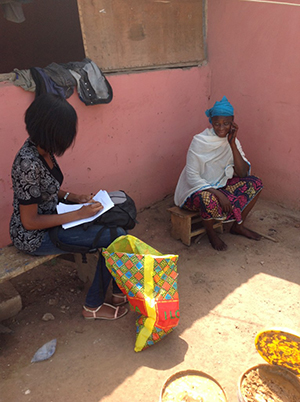Survey finds sources of contamination in Ghanaian peanut products
University of Georgia, Peanut & Mycotoxin Innovation Lab
 Peanuts and peanut-based products are highly nutritious foods consumed around the world. In Ghana, local processors use locally-grown peanuts to produce three popular products – peanut oil, kulikuli (a local snack food) and khebab powder (a seasoning). With the goal of improving food quality, the Peanut & Mycotoxin Innovation Lab supported a study to assess the levels of microbial and mycotoxin contamination in these products. The study was conducted by Sylvia Baah-Tuahene as part of her master's research project at the University of Ghana under Dr. Agnes Budu and Professor F. K. Saalia.
Peanuts and peanut-based products are highly nutritious foods consumed around the world. In Ghana, local processors use locally-grown peanuts to produce three popular products – peanut oil, kulikuli (a local snack food) and khebab powder (a seasoning). With the goal of improving food quality, the Peanut & Mycotoxin Innovation Lab supported a study to assess the levels of microbial and mycotoxin contamination in these products. The study was conducted by Sylvia Baah-Tuahene as part of her master's research project at the University of Ghana under Dr. Agnes Budu and Professor F. K. Saalia.
The study consisted of a cross-sectional survey in Greater Accra, Northern Ghana and the Ashanti region near Kumasi. A pre-tested, semi-structured questionnaire was used to collect information on the processing methods and knowledge of good manufacturing and hygienic practices. Samples were collected from 10 local processors in each of the three regions, and at the various stages of traditional peanut processing – raw peanuts, roasted peanuts, peanut cake, peanut oil, kulikuli and khebab powder.
Samples were then analyzed in the CSIR Food Research Institute’s microbiology laboratory and in the Department of Nutrition and Food Science at the University of Ghana in Accra.
All of the processors surveyed were female. Over 65% were above the age of 35 years old, 93% had no formal education, and 50% had been processing peanuts for at least 20 years. Even though almost all of the processors had no formal education, most did have adequate knowledge and understanding of the causes of defects in peanuts, how to control those problems and many of the food safety issues related to peanut consumption. In most cases, the processor's chief goal was to extract and sell peanut oil, and use the peanut cake obtained after oil extraction to make and sell kulikuli and khebab powder.
From the laboratory results, there were significant differences in the physical and chemical properties (e.g., impurities, moisture content, chemical composition and texture) among the various samples, likely due to the use of different peanut cultivars and processing methods. More critical were the high levels of microbial and aflatoxin contamination detected. All of the kulikuli and khebab powder samples had unacceptably high levels of microbial contamination, including E. coli and other faecal coliforms.
Aflatoxin contamination levels of the products were also far in excess of regulatory limits, ranging from over 550 ppb in raw peanuts to around 100 ppb in most all samples of peanut cake, kulikuli and khebab powder. Peanut paste and peanut oil generally had the lowest levels, although some samples of peanut oil from the Northern region were as high as 65 ppb. Levels in raw peanuts were surprisingly low in our samples from Accra compared to the other regions, suggesting that sorting can be effective, however, the level of aflatoxin detected in the processed products did not vary much between regions, nor were these correlated to the level in the raw peanuts used by the processor. This implies that even though most processors sort the raw peanuts to remove highly contaminated nuts, other steps such as milling, lead to aflatoxin contamination.
Based on the results from this study, it is recommended that peanut processors be further educated and provided practical training on the importance of good manufacturing and hygienic practices. The manual sorting procedures developed by the Peanut & Mycotoxin Innovation Lab need to be more widely promoted and adopted by processors. Further research should be done at the level of the local millers to determine exactly how contamination occurs and what might be done to reduce this. This could be especially important since millers often process many types of commodities, including corn that is also often contaminated by mycotoxins.
Future research by the Peanut & Mycotoxin Innovation Lab will focus on developing a HACCP system for traditional processing of peanut oil and its by-products that can be used to train local processors, and ultimately reduce the levels of microbial and aflatoxin contamination of these important and popular foods.
-Published January 28, 2015
